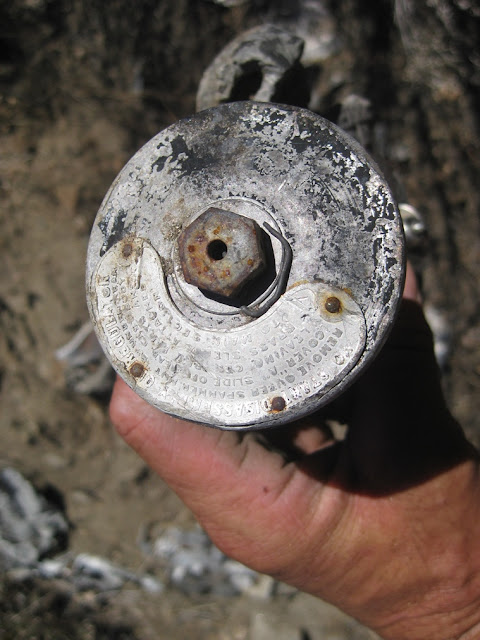Designated the XP-40, the prototype took its first flight in October, 1938 and was serial number 39-156.
A wartime picture of a P-40 that is much like the subject of this post.
Curtiss P-40 Warhawk Specifications
Wingspan: 37 ft. 4 in.Length: 31 ft. 8 in.
Height: 12 ft. 4 in.
Empty Weight: 6,000 lbs
Gross Weight: 8,850 lbs
Top Speed: 346 mph
Service Ceiling: 25,000 ft.
Range: 950 miles
Engine: One Allison 1040 hp V-1710-33 (C15)
The weapons installed were two 0.50-inch machine guns, mounted in the upper nose and synchronized to fire through the propeller arc and one 0.30-inch machine gun in each wing.
On October 24, 1940, 19 Curtis P-40 Warhawks of the 57th Pursuit Group left March Field at Riverside, California, to fly to McClelland Field, in Sacramento, California. A short time after takeoff, the aircraft encountered heavy overcast conditions, and many of them became separated. Four planes went down in the area of Kings Canyon, resulting in one pilot being killed, and three pilots parachuting to safety.
The P-40 Warhawk (Ser. # 39-213) flown by 2nd Lt. John Harold Pease suffered engine problems, suddenly filling the cockpit with smoke. Pease forced the cockpit open to vent the smoke and saw that his propeller had stopped turning, forcing the pilot bail out over the rocky and cold High Sierras.
Remarkably Pease landed unscathed, gathered up his parachute and hiked to a deserted hunter's cabin using his parachute to keep warm.
This airplane crash site location has remained unknown for almost 75 years until a cross country hiker spotted the wreckage. A SoCal aviation wreck expert, Pat Macha put together a group of seven hardy souls to hike out and validate the wreckage on-site and identify key components of the plane.
Starting at 8 AM it would turn out to be a long day of cross country navigation for the hikers to reach and inspect the hidden site.My friend Alan and I sported well prepared packs.
In my pack I toted:
5 liters of water due to high temps and unknown water source availability
decent first aid kit with emphasis on foot care, also water purification tablets
Wouxun UV8D radio
ESEE-6 blade, Delica folder and a Gerber Multitool
Bic lighter
light fleece, long sleeved shirt, windbreaker, gloves and shemagh
maps, compass, SPOT beacon and GPS
small camera
foil survival blanket
food to last the day with a little extra
large trash bag
headlamp
spare batteries
toilet paper
Sharing the woods with bears.
This tag from the aircraft's body positively identifies this wreck as a Curtiss 87 series, manufactured on June, 1940
The left and right landing struts with the gear assembly that rotated the tires to fit flush with the wings.
The Allison V-12 looked much like this before the crash
After the crash the engine block is broken and the internal parts strewn about.
The engine's mechanically driven supercharger vane assembly, slightly flattened from original condition. The impeller is the rusty section and the fixed diffuser (cast aluminum) is behind it.
This color photo shows a great view of the supercharger's impeller in a functioning engine
The gear drive on the back of the impeller plate.
These diagrams will help to understand the function and placement of the supercharger (on the far right of the engine cutaway diagram)
This factory image shows the impeller's gear train that derived power from the big V-12 engine's crankshaft.
This factory image shows the whole air induction assembly with inlet screen, carburetor, supercharger housing and air intake manifold.
The pilot's oxygen demand regulator with a data plate describing disassembly procedures.
The engine's oil Y-drain valve, part number 37D6114-6, a design also used on radial engine planes.
The oil Y-valve can be spotted in this factory diagram with the handle colored green.
Other pieces of the wreck:
Portion of aluminum skin with a small air scoop, unknown function.
The seven happy and tired explorers after their all day discovery hike was over. Photo courtesy of Pat Macha
Altogether we were on the trail for 10 hours, most of that being hiking
time. This trip thoroughly tested my endurance and my land navigation
skills and I felt confident that I could handle an unexpected emergency
and overnight stay.
Please respect aircraft wrecks sites so that other adventurers may see them intact. Many sites are protected by a host of federal and local laws.
Please respect aircraft wrecks sites so that other adventurers may see them intact. Many sites are protected by a host of federal and local laws.





























